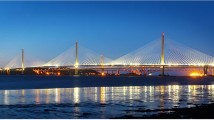Abstract
As a practical alternative to the preliminary wind tunnel tests in the wind-resistant design of the bridge structures, an efficient two-step computational method is proposed to predict the dynamic response of the long-span bridge structures by unsteady wind loads due to vortex-shedding. By decoupling the wind-structure interaction problem, firstly computational fluid dynamics analysis using two-dimensional model of the bridge deck section are carried out to evaluate the unsteady wind loads on the bridge deck. Three-dimensional dynamic analysis of the bridge structure under unsteady wind loads are followed to investigate vortex-excited oscillations of the bridge. Reasonable agreements are obtained between the predictions by the computational analyses and the existing wind tunnel measurements. Although various assumptions introduced in the modeling process should be justified to systematically augment the computational method, it may serve as a preliminary design supporting tool for evaluation of dynamic response of the bridge due to vortex-induced unsteady wind load before undertaking serious wind tunnel tests.
Similar content being viewed by others
References
CFD Services (1994).CFDS-FLOW3D User Manual. Release 3.3, Oxfordshire, UK.
Franke, R. and Rodi, W. (1991). “Calculation of Vortex Shedding Past a Square Cylinder with Various Turbulence Models,Proc. 8th Symp. on Turbulent Shear Flow, Munich, Germany, Sept. 9–11, 20.1.1–20.1.6.
Fujiwara, A., Kataoka, H., and Ito, M. (1993). “Numerical Simulation of Flow Field Around an Oscillating Bridge Using Finite Difference Method”,J. Wind Engineering and Industrial Aerodynamics, Vol. 46, & 47, pp. 567–575.
Hughes, T.J.R. and Jansen, K. (1993). “Finite Element Methods in Wind Engineering”,J. Wind Engineering and Industrial Aerodynamics, Vol. 46 & 47, pp. 297–313.
Ishikawajima-Harima Heavy Industries Co., Ltd. (1973).Namhae Bridge Final Report.
Jeong, Un Yong (1997). “Numerical Simulation of Unsteady Turbulent Flow around Bluff-shaped Bodies to Evaluate the Wind-resistant Stability of Civil Structures”,Journal of the Wind Engineering Institute of Korea, Vol. 1, No. 1, pp. 127–134.
Jeong, Un Yong and Koh, Hyun Moo (2000). “A finite element analysis of turbulent wind flow for the evaluation of wind-resistant stability of structures”,Journal of KSCE, Vol. 20, No. 2-A, pp. 217–223.
Jeong, Un Yong and Kwon, Soon-Duck (2000). “Prediction of flutter onset velocity of flat plate using CFD”,Proceedings of Annual Conference of Wind Eng. Inst. of Korea, Kumi, pp. 134–137.
Kato, M. and Launder, B.E. (1993). “The modelling of turbulent flow around stationary and vibrating square cylinders”,Proc. 9th Symp. on Turbulent Shear Flow, Kyoto, Japan, Aug. 16–18, 10.4.1–10.4.6.
Koopman, G.H. (1967). “The vortex wakes of vibrating cylinders at low Reynolds numbers”,J. of Fluid Mechanics, Vol. 28, No. 501.
Kovacs, I., Beyer, K. and Oba, N. (1996). “Computer simulation of the dynamic response of wind-loaded large bridges under limit conditions”,Proceedings of CWE96, August 4–8, Colorado, USA.
Kuroda, S. (1996). “Numerical simulation of flow around box girder of long-span suspension bridge”,Proceedings of CWE96, August 4–8, Colorado, USA.
Kuroda, S. (1998). “An application of Navier-Stokes simulation in bridge aerodynamics”,Bridge Aerodynamics, Balkema, Rotterdam, pp. 337–347.
Larsen, a. and Walther, J.H. (1996). “Aeroelastic analysis of bridge sections based on discrete vortex simulations”,Proceedings of CWE96, August 4–8, Colorado, USA.
Larsen, A. (1997). “Advances in aeroelastic analyses of suspension and cable-stayed bridges”.Proc. 2nd European and African Conference on Wind Engineering, Genova, pp. 61–75.
Larsen, A., and J.H. Walther (1996). “A new computational method for assessment of the aeroelastic stability of long span bridges”.Proc. 15th IABSE Congress, pp. 93–98.
Larsen, A., and J.H. Walther (1997). “Aeroelastic analysis of bridge sections based on discrete vortex simulations”. J.Wind Engng. and Industrial Aerodynamics, Vol. 67-68, pp. 253–265.
Larsen, A., T. Vejrum and S. Esdahl (1998). “Vortex models for aroelastic assessment of multi element bridge decks”,Bridge Aerodynamics, Balkema, Rotterdam, pp. 313–325.
Lee, S., Kim, J.D. and Lee, J.S. (1996). “An analysis of vortex-induced oscillation of long-span bridges”,Proceedings of CWE96, August 4–8, Colorado, USA.
Lee, J.S. and Lee, S. (1997). “Computational method for the prediction of dynamic response of long-span bridges due to unsteady wind load”,Proceedings of HPC ASIA 97, April 28–May 2 Seoul, Korea.
Lee, S., Lee, J.S. and Kim, J.D. (1997). “Prediction of vortex-induced wind loading on long-span bridges”,J. Wind Engineering and Industrial Aerodynamics, Vol. 67 & 68, pp. 267–278.
MSC (1994). MAC/NASTRAN Quick Reference Guide. Version 68, California, USA.
Murakami, S. (1996). “Current status and future trends in Computational Wind Engineering”,Proceedings of CWE96, August 4–8, Colorado, USA.
Murakami, S. Mochida, A. and Sakamoto, S. (1994). “CFD analysis of wind-structure interaction due to vortex shedding”,The Third World Congress on Computational Mechanics, August 1–5, 1994, Chiba, Japan, pp. 315–324.
Nomura, T. (1993). “A numerical study on vortex-excited oscillations of bluff cylinders”,J. Wind Engineering and Industrial Aerodynamics 54, pp. 75–83.
Press, W.H., Flannery, B.P., Teukolsky, S.A. and Vetterling, W.T. (1986).Numerical Recipes: The Art of Scientific Computing, Cambridges Univ. Press, New York, USA
Samwoo Institute of Construction Technology (1993).An Experimental Study of Seohae Cable-Stayed Bridge.
Selvam, R. Panneer (1998). “Computational procedures in grid based computational bridge aerodynamics”,Bridge Aerodynamics, Balkema, Rotterdam, pp. 327–336.
Tsuchiya, M., Murakami, S., Mochida, A., Kondo, K. and Ishida, Y. (1996). “Development of newk-ε model for flow and pressure fields around bluff body”,Proceedings of CWE96, August 4–8, Colorado, USA.
Yang, W.W., Chang, T.Y.P. and Chang, C.C. (1996). “An efficient wind field simulation technique for bridges”,Proceedings of CWE96, August 4–8, Colorado, USA.
Author information
Authors and Affiliations
Corresponding author
Additional information
The manuscript for this paper was submitted for review on September 1, 2000.
Rights and permissions
About this article
Cite this article
Lee, J.S. A two-step computational method for the analysis of vortex-induced oscillation of the bridge. KSCE J Civ Eng 4, 191–199 (2000). https://doi.org/10.1007/BF02823966
Issue Date:
DOI: https://doi.org/10.1007/BF02823966




